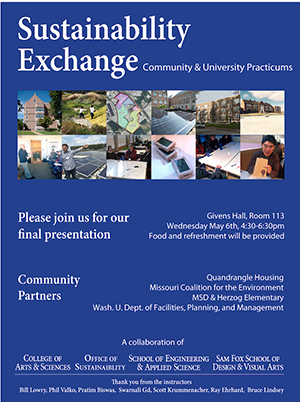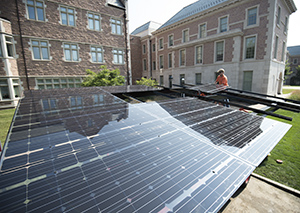
This spring, the schools of Arts & Sciences, Engineering & Applied Science and the Sam Fox School of Design & Visual Arts at Washington University in St. Louis launched “The Sustainability Exchange,” a unique course bringing students from across campus together to work on interdisciplinary teams to tackle real-world challenges in energy, environment and sustainability.
Using the campus and community as a living laboratory, the course was created by an interdisciplinary team of deans and faculty to create an upperclassman experience.
“It’s designed to help our students build a bridge from classroom learning to real-world problem-solving,” said Phil Valko, assistant vice chancellor for sustainability and adviser for one of the components of the course, the Quadrangle Green Rehab Experiment team.
Pratim Biswas, PhD, the Stanley & Lucy Lopata Professor and chair of the Department of Energy, Environmental & Chemical Engineering in the School of Engineering, is adviser for the Solar Energy Solutions team. He said the course also represents an intersection of the university’s interests.
“We are engaged in education and teaching students, but at the same time are engaged in research to discover new things and unravel the unknown,” Biswas said.
About the course
Students participate in significant projects with clients and partners, including facilities management at the university; the Missouri Coalition for the Environment; and the Metropolitan Sewer District (MSD).
These projects are developed with, and guided by, faculty advisers with the intention of delivering applicable end products for community problems requiring innovative methods and solutions.
The course gives students an opportunity to engage in the community and work hands-on with the content they are learning. “We talk about sustainability in abstract terms, but this course and the projects give it a concrete application,” said Scott Krummenacher, PhD, postdoctoral teaching fellow in the Department of Political Science in Arts & Sciences and co-adviser for the RadioAction team, which is working on the West Lake Landfill project.
An example of a project that has positively impacted the community and strengthened connections within the university is the Stormwater Management Using Green Infrastructure Project, led by Raymond Ehrhard, senior research associate in the Department of Energy, Environment & Chemical Engineering in the School of Engineering.
In this project, students are working with MSD at Herzog Elementary School in the St. Louis Public School District.
“Our students are not only assisting the school on green infrastructure approaches to reduce storm runoff, but they also are going into the classroom and talking to elementary-school students about sustainability,” Ehrhard said.
“The interdisciplinary nature of the course is unique as it not only brings together a variety of subjects, but also a variety of students,” Biswas said. “In this course, students from different schools come together to address these complex problems.”
“Typically, interdisciplinary projects might be political science and economics – but this is crossing so many different schools,” said William Lowry, PhD, professor of political science and co-adviser for the RadioAction team.
“When you bring different people together, they think about problems in different ways. You get synergy; a sum that’s greater than the parts,” Lowry said.
The course also includes a one-hour seminar taught by Bruce Lindsey, dean of architecture and the E. Desmond Lee Professor for Community Collaboration. The seminar is intended to give students an opportunity to collaboratively explore topics, such as perception, representation, technology, group intelligence and context-learning. In addition, a significant portion of the seminar is devoted to design thinking and its intersection with environmental problems.
The seminar facilitates the interdisciplinary nature of the course by bringing together academically diverse groups of students to work together and discuss their respective projects.
As the semester went on, the class transformed its understanding of expectations of the course. “They have an opportunity to work as a team on sustainability challenges while dealing with a specific client and project,” Ehrhard said. “As a result, one thing they are definitely learning is how to keep realistic expectations.”
The founders of the Sustainability Exchange have ambitious goals for the course. “There are so many potential projects,” Lowry said. “I can imagine the Sustainability Exchange becoming a pretty big deal and having a prominent place within campus.”
More about the projects
The Retrocommissioning: Enhance Performance & Minimize Energy Consumption project is advised by Ehrhard, and sponsored by the Washington University Building Energy Research Center. The project seeks to discover innovative solutions for reducing energy use and the associated carbon footprint in campus facilities.
The Stormwater Management Using Green Infrastructure Techniques project is also advised by Ehrhard and sponsored by MSD. MSD recently adopted a Stormwater Management Plan to reduce stormwater runoff and improve area water quality. Students on this project work with local engineers and MSD to design a Green Infrastructure project solution for a site in the MSD service area.
The West Lake Landfill project is advised by Lowry and sponsored by the Missouri Coalition for the Environment. The West Lake Landfill, located in north St. Louis County, is severely contaminated with radioactive waste that dates to uranium processing for nuclear weapon production. The project team assists the coalition in producing relevant documents, as well as a report that documents actions and progress for subsequent teams.

The Solar Energy System & Energy Storage Units project is advised by Biswas and sponsored by Washington University. Students work with the distributed solar photovoltaic systems that are integrated into the building grid system and designed with electric vehicle charging station to analyze the functioning of the system, as well as collect and analyze the solar production and energy usage. The team is tasked with designing an energy storage system and doing a cost-benefit analysis of this system.
The Quadrangle Green Rehab Experiment project is advised by Valko and is an ongoing partnership between architecture students, construction management students, and Quadrangle Housing. Its goal is to transform a 100-year-old apartment building into a net-zero energy structure. Students work with the Office of Sustainability to analyze preliminary energy data, research best practices and develop both policy- and practice-based recommendations for advancing net-zero energy design and construction in Missouri and beyond.
Registration is now open for the Sustainability Exchange course in fall 2015, listed under I50-405/L82-405/E44-412. Students are invited to place themselves on the waitlist.
Projects will be announced and applications will open in June. Students will be informed of their acceptance by the end of July.
Current sustainability exchange students will give final presentations about their projects on Wednesday, May 6, in Givens Hall, Room 113, from 4:30-6:30 pm.
For more information, contact Liz Kramer, assistant director of community-based design & sustainability, at kramer@wustl.edu and visit sustainability-exchange.tumblr.com.